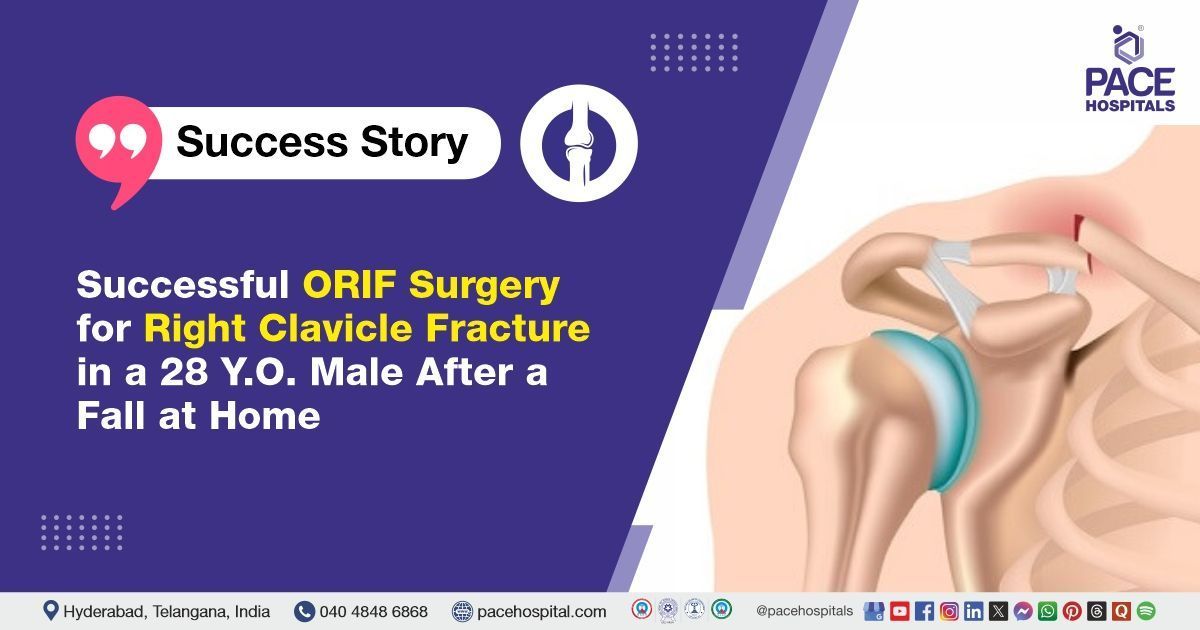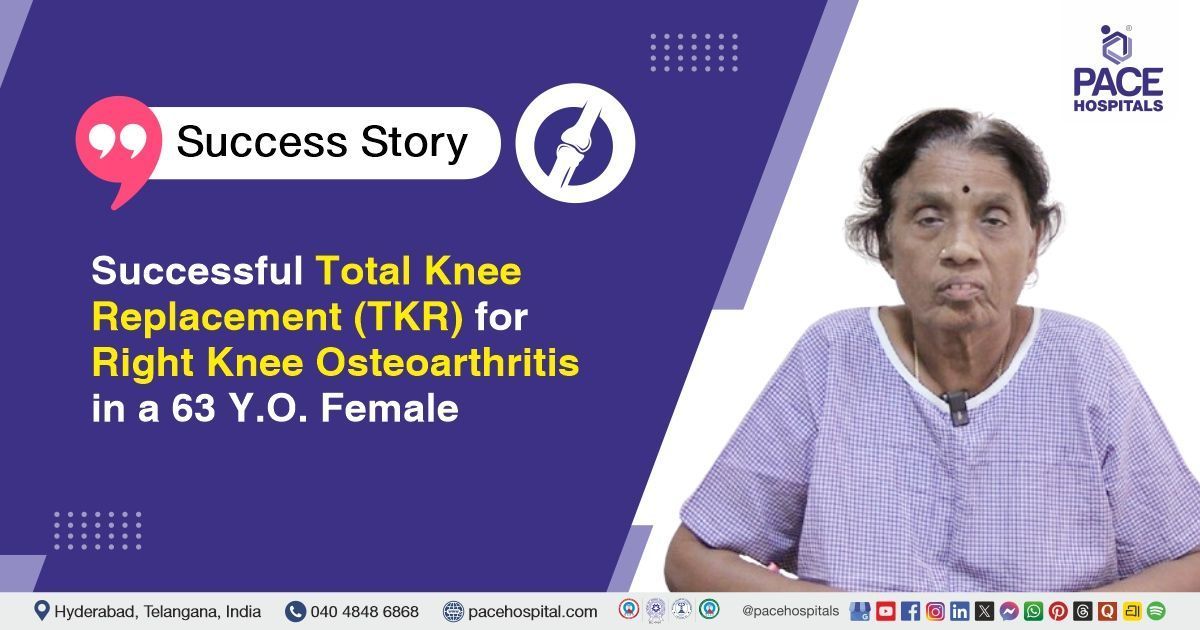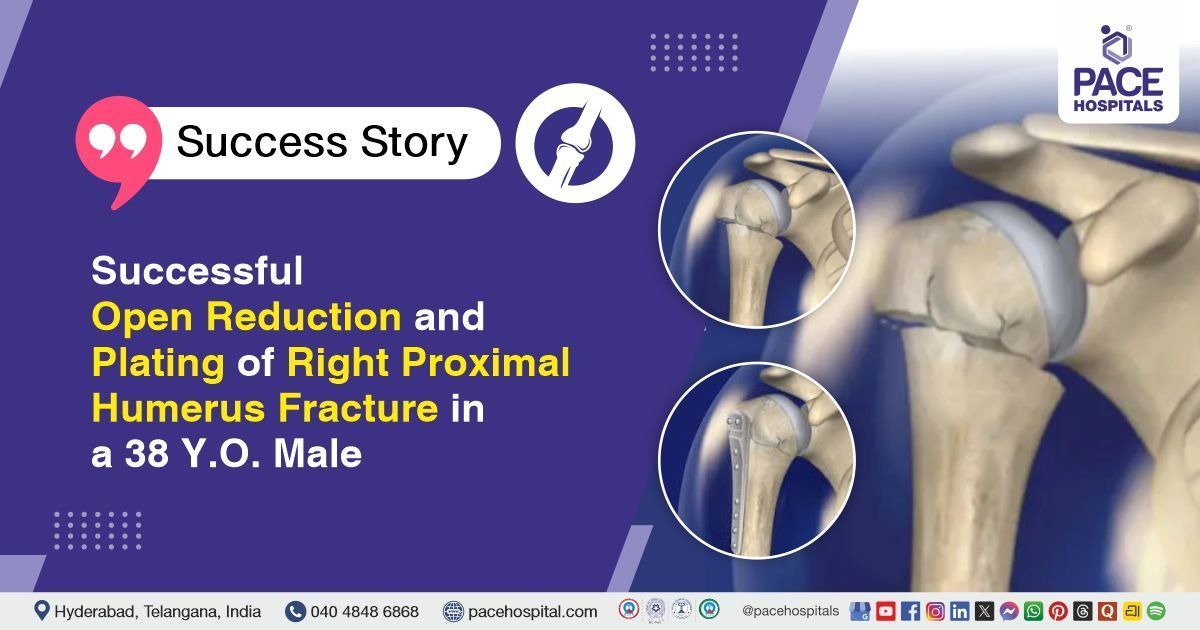Successful ORIF Surgery for Right Clavicle Fracture in a 28 Y.O. Male
PACE Hospitals
PACE Hospitals' expert Orthopedic team successfully performed an open reduction and internal fixation (ORIF) of the right clavicle on a 28-year-old male patient who presented with pain over the right collarbone and difficulty moving his right shoulder, following a fall down the stairs at home. Surgery was performed to relieve symptoms, prevent further complications, and enhance the patient's mobility and quality of life.
Chief Complaints
A 28-year-old male patient with a
body mass index (BMI) of 24.3 presented to the Orthopedics Department at
PACE Hospitals, Hitech City, Hyderabad, with chief complaints of pain over the right collarbone and difficulty moving the right shoulder joint, following a fall down the stairs at home. The pain was sharp and worsened with arm movement, which had started to interfere with his daily activities and mobility.
Past Medical History
The patient had no known history of drug allergies or chronic illnesses. The absence of comorbid conditions was considered clinically favourable, as it minimised the risk of intraoperative and postoperative complications and supported a smoother, more stable recovery.
On Examination
Upon admission to PACE hospitals, the patient was hemodynamically stable. The respiratory system showed bilateral air entry; the cardiovascular system had audible S1 and S2 heart sounds. The abdomen was soft and non-tender, and the central nervous system examination indicated that the patient was alert, conscious, and oriented to time, place, and person.
On systemic examination, the right clavicle was observed to be deformed, and there was also noticeable swelling in the same area. Upon inspection, the middle third of the right clavicle revealed significant discomfort. When the area was gently moved, a grating sensation known as crepitus was felt, indicating bone involvement. When attempting to move the arm, there was severe pain and limited range of motion at the right shoulder joint. However, no distal neurovascular deficit was found, indicating that the distal arm's blood supply and nerves were intact.
Diagnosis
Following the examination, the Orthopedic team performed a comprehensive assessment, which included a thorough review of the patient’s medical history and clinical findings. Based on characteristic symptoms, a provisional diagnosis of acomminuted displaced fracture of the middle third of the right clavicle (collarbone) was made.
To support the clinical findings, laboratory tests and imaging studies were undertaken.
On X-ray, the patient was found to have a comminuted, displaced fracture of the middle third of the right clavicle. The images showed a clear break in the middle part of the right collarbone, with multiple bone fragments and the broken ends displaced from their normal position. There was angulation or overlap at the fracture site. The acromioclavicular and sternoclavicular joints appeared intact, and there was no evidence of joint dislocation. These radiographic findings correlated with the patient's symptoms and confirmed the provisional diagnosis, guiding the team toward planning appropriate surgical intervention.
Based on the confirmed diagnosis, he was advised to undergo
Collarbone Fracture treatment in Hyderabad, India, under the care of the Orthopedic Department, ensuring comprehensive management.
Medical Decision-Making (MDM)
Given the patient’s symptoms, functional limitations in daily activities, and the confirmed diagnosis of the Fracture of the right clavicle, surgical intervention was considered essential.
Following a detailed discussion with the patient and his guardians, Dr. Anand V Agroya, Consultant Orthopedic Surgeon, recommended open reduction and internal fixation (ORIF) with Titanium Plate and Screws (PDL) for the shaft fracture of the right clavicle as the most appropriate and effective treatment to achieve optimal stabilization and promote recovery.
The patient and his family were thoroughly counselled regarding the nature of the condition, the surgical procedure, potential risks, and the necessity of Open reduction and plating (ORIF) of the right clavicle shaft to restore function and stabilize the right clavicle.
Surgical Procedure
Following the decision, the patient was scheduled to undergo open reduction and internal fixation (ORIF) of the right clavicle Surgery in Hyderabad at PACE Hospitals, under the supervision of the expert orthopedic Department.
The following steps were carried out during the procedure:
- Preoperative Preparation and Anesthesia: The patient underwent preoperative evaluation and was cleared for surgery. The patient was placed in the supine position, and general anaesthesia was administered.
- Surgical incision and Exposure: A longitudinal incision was made just below the right clavicle, centered over the fracture site. The underlying muscles and tissues were carefully dissected to expose the clavicle, with attention paid to protecting the supraclavicular nerves.
- Fracture Assessment, Reduction, and Fixation: The fracture was identified as a comminuted, displaced fracture of the middle third of the clavicle. Interfragmentary screws were utilized to maintain alignment and temporarily stabilize the fracture fragments. Subsequently, the bone fragments were realigned to restore normal anatomy, and a 3.5 System PDL Titanium plate (7-hole) was placed over the fracture. A total of 7 screws were inserted to securely fixate the bone, and the alignment and stability of the fracture were confirmed both visually and by manual assessment prior to wound closure.
- Hemostasis and Closure: Hemostasis was successfully achieved. The wound was closed in multiple layers. Subcuticular suturing was used for closure.
Postoperative Care
The postoperative period was uneventful. The patient was mobilized early and was encouraged to walk with support during the hospital stay under supervision. He received intravenous antibiotics, analgesics, and supportive treatment. Wound dressings were performed regularly and remained clean and dry, with no signs of infection. At the time of discharge, the patient was hemodynamically stable, his pain was well controlled, and the surgical site appeared healthy.
Discharge Medications
Upon discharge, the patient was prescribed a course of oral medications to support postoperative recovery and prevent complications. This regimen included antibiotics to reduce the risk of surgical site infection, analgesics for effective pain management, and proton pump inhibitors (PPIs) to prevent gastrointestinal irritation associated with analgesic use. Additional supportive treatments were also advised as part of the post-discharge care plan.
Advice on Discharge
The patient was advised to continue using an arm pouch for support for the next two weeks until further review. Instructions were given to keep the surgical dressing dry and to avoid getting it wet. Chest physiotherapy was continued as previously recommended to promote lung expansion and prevent complications. These measures were implemented as part of the postoperative rehabilitation plan.
Emergency Care
The patient was informed to contact the Emergency ward at PACE Hospitals in case of any emergency or development of symptoms such as fever, abdominal pain, and vomiting.
Review and Follow-Up
The patient was advised to return for a follow-up visit with the Orthopedic Department at PACE Hospitals after 5 days for further evaluation.
Conclusion
This case highlights the effectiveness of Open reduction and internal fixation (ORIF) of the shaft of right clavicle in restoring shoulder alignment and function, reducing pain, and improving quality of life in patients with clavicle fractures, enabling a return to daily activities after recovery.
Advancements in Titanium Fixation for Clavicle Fracture Stabilization
A significant advancement in modern orthopedic surgery for the stabilization of clavicle fractures is the use of titanium implants, such as the 3.5 system PDL titanium plate with 7 screws. Titanium is preferred for younger, active patients who need long-term durability because of its exceptional strength-to-weight ratio, low risk of allergic reaction, and excellent biocompatibility. In this instance, the orthopedic doctor / orthopedic surgeon decision to use a titanium plate ensured optimal healing conditions, structural stability, and exact anatomical alignment. Ultimately, this approach supported a quicker recovery, restored function, and return to daily activities by lowering the risk of hardware-related complications and enabling early mobilization.
Share on
Request an appointment
Fill in the appointment form or call us instantly to book a confirmed appointment with our super specialist at 04048486868











